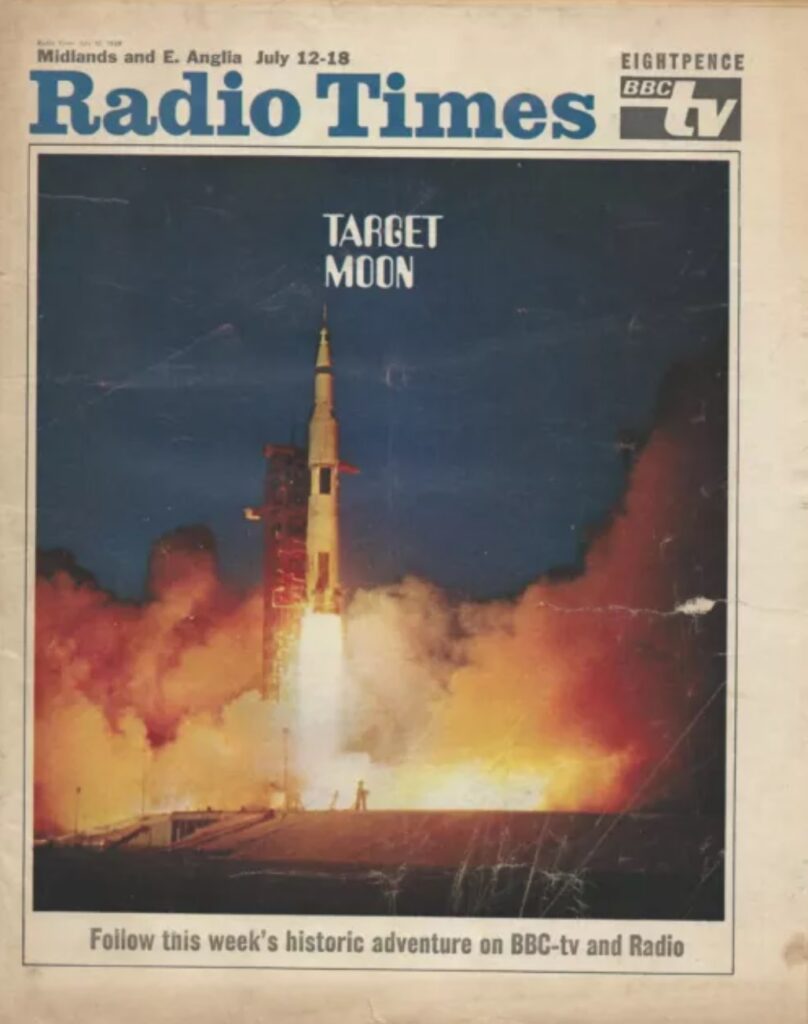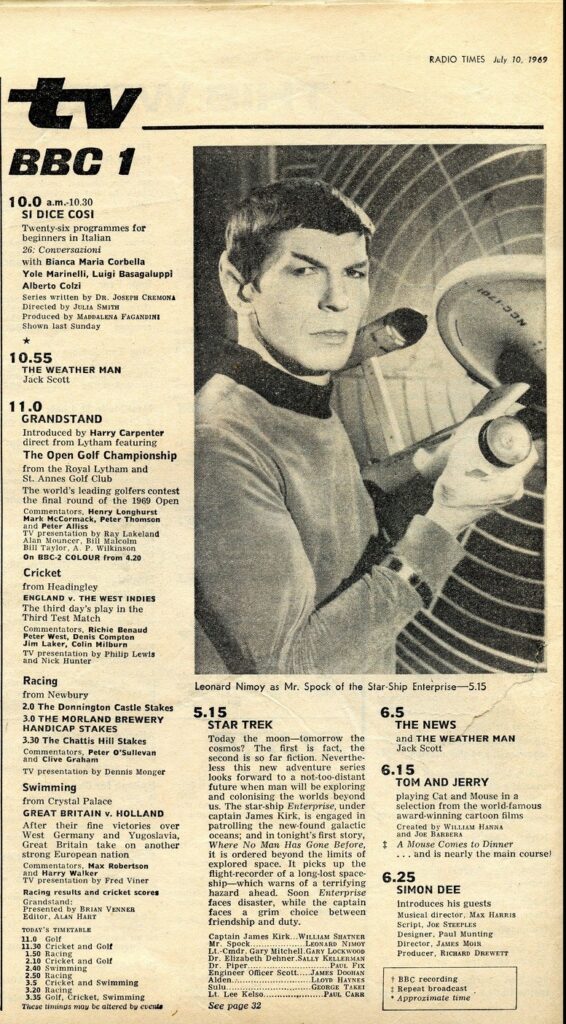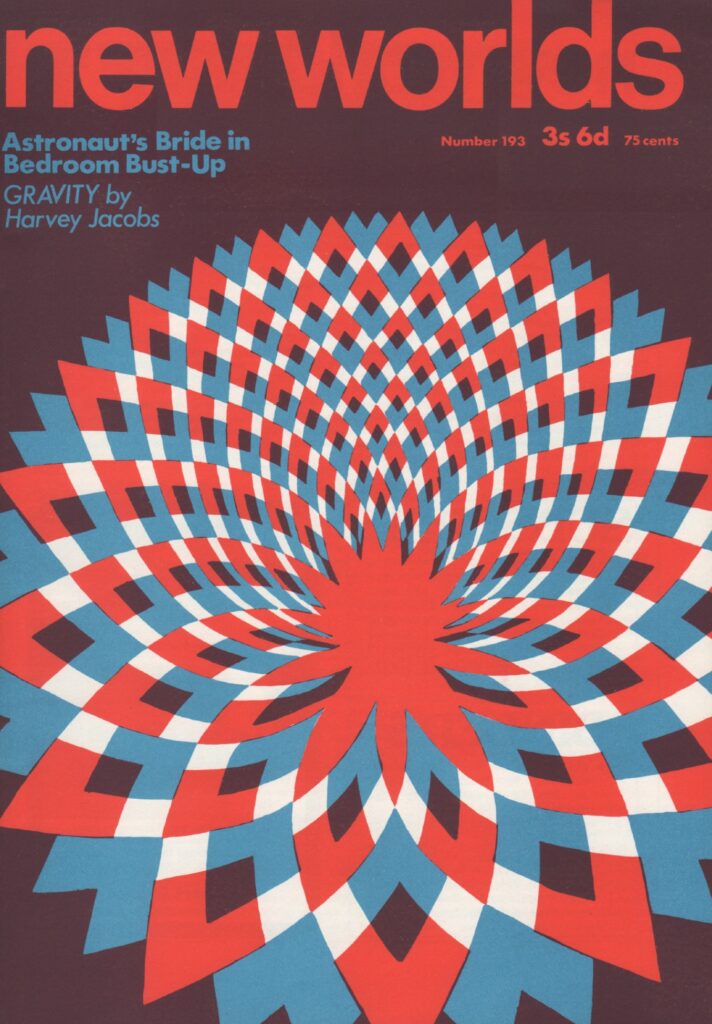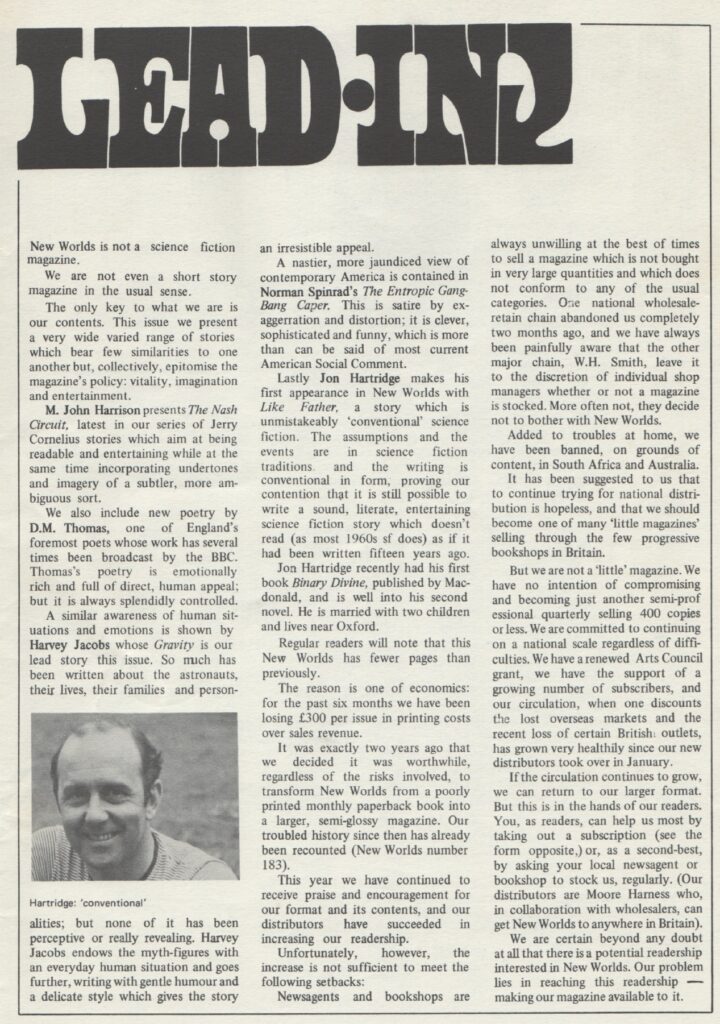
by Fiona Moore
The big news over here this month is the introduction of the fifty-pence piece, replacing the ten-shilling note. It’s the beginning of decimalisation! Finally they are bringing us into line with the rest of the world.

My students are currently enamoured of a new wacky surreal sketch-comedy programme, a spiritual descendant of At Last The 1948 Show, called Monty Python’s Flying Circus. What I’ve seen of it suggests it’s a bit hit-and-miss, but it’s early days yet.

Anyway, on to New Worlds! Who, readers may notice, have missed a month. There’s an apology in the Lead-In for the “slightly erratic” publication schedule, and I hope it’s not more signs of trouble for the mag. Which, once again, has a table of contents bereft of women. The cover promises us JACK TREVOR STORY’S NEW NOVEL—don’t worry, it’s serialised, not the whole thing.
 Cover of November 1969 issue, by John Bayley
Cover of November 1969 issue, by John Bayley
Lead-In
This month, the Lead-In mostly introduces Jack Trevor Story and his exciting background, which includes suing the police for terrorisation. The relevance of this fact will become obvious shortly. Elsewhere, I’m pleased to read that Langdon Jones has a new anthology coming out, but sorry that Thomas M. Disch’s Camp Concentration hasn’t been well received, since he’s one of my favourite New Wave writers. Finally, I’m glad that Ian Watson, a young British writer living in Tokyo with whom I’ve cultivated some acquaintance on trips to the Far East, has a story this issue.
The Wind in the Snottygobble Tree, by Jack Trevor Storey
 Art by Roy Cornwall and definition of Snottygobble
Art by Roy Cornwall and definition of Snottygobble
Despite all the buildup, I didn’t really like this one. A man who works in a travel agent’s is either correctly or falsely suspected of abetting espionage, and goes on the run from Special Branch, during which time he has rather more sex than one would imagine a fairly boring and egotistical fellow like this would have in real life. Two stars.
New and Reasonably New Poems, by Thomas M. Disch
 Art by J Myrdahl
Art by J Myrdahl
I like Disch as a prose writer, but hadn’t read his poems before. There are seven, and they’re what you might expect from Disch; full of body horror and sharp wit, with themes like politicians, surgery and really bad sex. Four stars.
The Girl Who Went Home to Sleep…, by Jannick Storm
 Art and words by Jannick Storm
Art and words by Jannick Storm
This is an experimental/concrete piece, with verses underneath photographs of a girl, as advertised, going home and sleeping. It took me two tries to work out how to read it (start with the sentence in block capitals, then read the three above it in reverse order, and then the three below it in normal order– you can follow along at the illustration above) but once I did it was fine. The story itself is a little vignette about a woman having an affair and maybe regretting it, or maybe not. Three stars.
Roof Garden under Saturn, by Ian Watson
 Art by R Glyn Jones; wow.
Art by R Glyn Jones; wow.
This piece is set in a future world under Saturn (presumably on one of its moons), which is a giant department store, where capitalism has run riot and is taken to its logical but most absurd extremes. Our protagonists, Suzuki and Kim, try in various ways to escape or resist this culture: One succeeds, the other fails. It’s refreshing to read a story with Asian protagonists (one of them Korean!), and it’s also mostly free of Orientalist imagery. Clearly, it helps to have stories about Asia from people who actually live there! Four stars.
Alien Territory, by John T. Sladek
 The first page of "Alien Territory" by John T. Sladek
The first page of "Alien Territory" by John T. Sladek
Another of these concrete poems/stories/literary experiments that New Worlds likes. The story, about a photojournalist covering a war and becoming increasingly traumatised by it, consists of fragmented paragraphs which can be read in several different orders, and it was fun reading it a few different ways and seeing how the results compared. Again, you can see what I mean from the above picture. Three stars.
Travel to the Sun with Coda Tours, by Chris Lockesley
 art by Peter Southern
art by Peter Southern
A charming short piece about a man overcoming suicidal despair and coming to realise there’s joy in the world after all. The prose is lovely and the descriptions of finding beauty in a drab high street are worth reading. Three stars.
The End of the Cycle, by Langdon Jones
 Art by R Glyn Jones
Art by R Glyn Jones
This is the Jerry Cornelius episode for this issue, and the New Worlds team seem to be becoming bored with them, as it’s in the form of a poem. It reads almost as self-parody, with verses about Jerry’s clothes, and sex, and time travel, but at least it’s a) a novelty and b) short. Two stars.
Books: John Clute, “Pouring Down”
John reviews Unspeakable Practices, Unnatural acts, a short fiction collection by Donald Barthelme; Slaughterhouse-Five by Kurt Vonnegut; Barefoot in the Head by Brian Aldiss; Steps by Jerzy Kosinski; Babel by Alan Burns; and The Novel on Yellow Paper by Stevie Smith. He couches it all in terms of the American versus the European novel, which gives the piece thematic unity. He’s ambivalent about most of them, but quite likes the Kosinski and the Burns (though he warns the latter might be offputting to Burns neophytes). He really doesn’t like the Vonnegut.
M John Harrison, “The Tangreese Gimmick”
John reviews The People Trap, a short fiction collection by Robert Sheckley; The New Minds by Dan Morgan; Emphyrio by Jack Vance; The Best from Fantasy and Science Fiction (Eighteenth Series); and The Herios Gamos of Sam and An Smith, by Josephine Sexton. He really likes the Vance and the Sexton, heavily recommending the latter, and it does sound like something that’s worth checking out.
R Glyn Jones, “Coke Culture’
 An example of pop art; well, something is popping anyway.
An example of pop art; well, something is popping anyway.
Glyn reviews Pop Art Redefined, by John Russell and Suzi Gablik and Image as Language by Christopher Finch. He finds the former overstated, and praises the latter for not trying to fit art into “movements” but instead approach artists individually.
So, will we get an issue next month or won’t we? I’ll leave readers on a cliffhanger…just as they've left me!



![[July 28, 1969] <i>New Worlds – on a Budget</i>, August 1969](https://galacticjourney.org/wp-content/uploads/2024/07/cover-august-69-672x372.jpg)


 Programme description from The Radio Times, 12th July.
Programme description from The Radio Times, 12th July. Cover by Charles Platt
Cover by Charles Platt 
 Photo by Gabi Nasemann
Photo by Gabi Nasemann  Sketch by R. Glyn Jones
Sketch by R. Glyn Jones  Photo by Gabi Nasemann
Photo by Gabi Nasemann 

![February 26, 1969] Springtime for Moorcock? <i>New Worlds</i>, March 1969](https://galacticjourney.org/wp-content/uploads/2024/02/NW-March-1969-672x372.png)

 Cover by Gabi Nasemann. Is this Moorcock horrified by his announcement?
Cover by Gabi Nasemann. Is this Moorcock horrified by his announcement?  Artwork by Mal Dean.
Artwork by Mal Dean.
 The magazine’s obsession with D.M. Thomas continues, with something given under the premise that it is a transcript of speech from Mr. Black, a schizophrenic, as he is treated. As the story progresses, in
The magazine’s obsession with D.M. Thomas continues, with something given under the premise that it is a transcript of speech from Mr. Black, a schizophrenic, as he is treated. As the story progresses, in 
 Bizarre artwork by Mal Dean, seemingly stuck in at random in the middle of this story.
Bizarre artwork by Mal Dean, seemingly stuck in at random in the middle of this story. Artwork by Mal Dean.
Artwork by Mal Dean. Continuing the war theme, now with poetry, this time from writer and reviewer MacBeth. His last prose piece was in July 1967. The Hiroshima Dream touches on themes that seem very Ballardian, so it seems a logical piece to follow Ballard. Death, destruction, dystopia….fifty tankas* all based around apocalypse and the nuclear bomb dropping at Hiroshima. Although it is shockingly dark, I prefer MacBeth to D. M. Thomas. 4 out of 5.
Continuing the war theme, now with poetry, this time from writer and reviewer MacBeth. His last prose piece was in July 1967. The Hiroshima Dream touches on themes that seem very Ballardian, so it seems a logical piece to follow Ballard. Death, destruction, dystopia….fifty tankas* all based around apocalypse and the nuclear bomb dropping at Hiroshima. Although it is shockingly dark, I prefer MacBeth to D. M. Thomas. 4 out of 5.


![[January 26, 1969] A New World Order <i>New Worlds</i>, February 1969](https://galacticjourney.org/wp-content/uploads/2024/01/New-Worlds-Feb-1969-672x372.jpg)
 Impressively startling cover by Gabi Nasemann.
Impressively startling cover by Gabi Nasemann. As expected, the usual nudity, not entirely related to the prose. Artwork by Gabi Nasemann.
As expected, the usual nudity, not entirely related to the prose. Artwork by Gabi Nasemann.
 Artwork by Gabi Nasemann.
Artwork by Gabi Nasemann.
 Table made up by J. G. comparing different writers. Notice the positioning of Pohl and Asimov and that of Burroughs (presumably William S., not Edgar Rice!), a sign of where this magazine seems to be going.
Table made up by J. G. comparing different writers. Notice the positioning of Pohl and Asimov and that of Burroughs (presumably William S., not Edgar Rice!), a sign of where this magazine seems to be going. Artwork by Haberfield.
Artwork by Haberfield. Artwork by John T. Sladek.
Artwork by John T. Sladek.
 Work by Mervyn Peake.
Work by Mervyn Peake. Artwork by Prigann.
Artwork by Prigann. Artwork by Prigann.
Artwork by Prigann.
 Artwork by Gabi Nasemann and Charles Platt.
Artwork by Gabi Nasemann and Charles Platt.
 An advertisement from this issue of Peake's better-known work.
An advertisement from this issue of Peake's better-known work.
